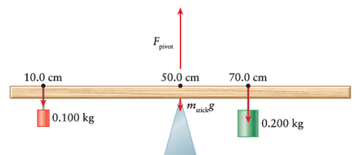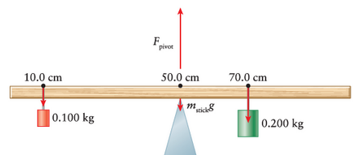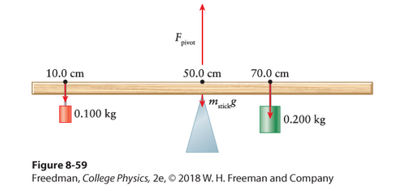
(a)
Clockwise and counter-clockwise torques acting on the board due to the four forces shown about an axis pointing out of the page at the 0−cm point.
Answer to Problem 101QAP
Clockwise torque= τclockwise=1.75Nm
Counter-clockwise torquey1 = 3 τcounter−clockwise=1.75Nm
Explanation of Solution
Given:

Formula used:
Torque can be interpreted as,
τ=Fr ( τ= Torque, F= Force, r= distance from rotational axis)
Calculation:
Consider the clockwise torque,
τclockwise=0.1kg*10ms−2*10*10−2m+50*10−3kg*10ms−2*50*10−2m+0.2kg*10ms−2*70*10−2m
τclockwise=(1+2.5+14)*10−1Nm
τclockwise=1.75Nm
Consider the vertical forces of the system,
Fpivot=(0.1kg+0.2kg+0.050kg)10ms−2
Fpivot=(0.350kg)10ms−2
Fpivot=3.5N
Consider the counter-clockwise torque,
τcounter−clockwise=3.5N*50*10−2m
τcounter−clockwise=1.75Nm
Conclusion:
Clockwise and counter-clockwise torques acting on the board due to the four forces shown about an axis pointing out of the page at the 0−cm point are;
τclockwise=1.75Nm
τcounter−clockwise=1.75Nm
(b)
Clockwise and counter-clockwise torques acting on the board due to the four forces shown about an axis pointing out of the page at the 50−cm point.
Answer to Problem 101QAP
Clockwise torque= τclockwise=0.4Nm
Counter-clockwise torque= τcounter−clockwise=0.4Nm
Explanation of Solution
Given:

Formula used:
Torque can be interpreted as,
τ=Fr ( τ= Torque, F= Force, r= distance from rotational axis)
Calculation:
Consider the clockwise torque,
τclockwise=0.2kg*10ms−2*20*10−2m
τclockwise=0.4Nm
Consider the counter-clockwise torque,
τcounter−clockwise=0.1kg*10ms−2*(50−10)*10−2m
τcounter−clockwise=0.4Nm
Conclusion:
Clockwise and counter-clockwise torques acting on the board due to the four forces shown about an axis pointing out of the page at the 50−cm point are;
τclockwise=0.4Nm
τcounter−clockwise=0.4Nm
(c)
Clockwise and counter-clockwise torques acting on the board due to the four forces shown about an axis pointing out of the page at the 100−cm point.
Answer to Problem 101QAP
Clockwise torque= τclockwise=1.75Nm
Counter-clockwise torque= τcounter−clockwise=1.75Nm
Explanation of Solution
Given:

Formula used:
Torque can be interpreted as,
τ=Fr ( τ= Torque, F= Force, r= distance from rotational axis)
Calculation:
Consider the clockwise torque,
τclockwise=Fpivot*50*10−2m
τclockwise=0.35N*50*10−2m
τclockwise=1.75Nm
Consider the counter-clockwise torque,
τcounter−clockwise=0.2kg*10ms−2*(100−70)*10−2m+0.050kg*10ms−2*(100−50)*10−2m+0.100kg*10ms−2*(100−10)*10−2m
τcounter−clockwise=(0.6Nm+0.25Nm+0.9Nm)
τcounter−clockwise=1.75Nm
Conclusion:
Clockwise and counter-clockwise torques acting on the board due to the four forces shown about an axis pointing out of the page at the 100−cm point are;
τclockwise=1.75Nm
τcounter−clockwise=1.75Nm
(d)
Verify the stability of the stick after the two masses have been added.
Explanation of Solution
Given:

Formula used:
Torque can be interpreted as,
τ=Fr ( τ= Torque, F= Force, r= distance from rotational axis)
Calculation:
Consider the conclusions of (a),(b),(c) parts,
According to conclusion (a),
τclockwise=1.75Nm
τcounter−clockwise=1.75Nm
So,
τclockwise=τcounter−clockwise...(1)
According to conclusion (b),
τclockwise=0.4Nm
τcounter−clockwise=0.4Nm
So,
τclockwise=τcounter−clockwise...(2)
According to conclusion (c),
τclockwise=1.75Nm
τcounter−clockwise=1.75Nm
So,
τclockwise=τcounter−clockwise...(3)
Conclusion:
According to (1),(2),(3) expressions,
Stability of the stick after the two masses have been added is still strong. In other words system has stabilized.
Want to see more full solutions like this?
Chapter 8 Solutions
COLLEGE PHYSICS,VOLUME 1
- A light source is incoming with 30 degrees with the normal force to an equilateral prism made out of a material withn=1.2 and it exits the prism. Draw the ray diagramarrow_forward1 Cartpole System Analysis The cartpole system (Fig. 1) consists of a cart of mass M moving along a frictionless track, and a pendulum of mass m and length 1 pivoting around the cart. The mass of the pendulum is assumed to be equally distributed along the rigid rod. The system is actuated by a horizontal force F applied to the cart. m Ө X F M Figure 1: Cart-pole as the combination of a cart and a pendulum. 1.1 Tasks 1. Draw the free-body diagram of the pendulum and cart, showing all forces acting on them. Note: Point the reaction force Fx as the coupling force between the pendulum and the cart in positive x-direction in the free-body diagram of the pendulum.arrow_forwardA light beam with intensity I=40W/m^2 passes through two polarizers. First polarizer makes 30 degrees with the y-axis and the second one makes 40 degrees with the x-axis. Find the final intensity as it exits both polarizers fora) Original beam is umpolarized b) Original beam is polarized in x direction c) Original beam is polarized in y-directonarrow_forward
- Find the critical angle between ruby and glass. Ruby has n=1.75 and glass has n=1.5Draw an approximate raydiagram for a beam coming 5 degrees less than the critical anglearrow_forwardCalculate the value of the force F at which the 20 kg uniformly dense cabinet will start to tip. Calculate the acceleration of the cabinet at this force F. Must include the FBD and KD of the system. Ignore friction.arrow_forward1) A 2.0 kg toy car travelling along a smooth horizontal surface experiences a horizontal force Fas shown in the picture to the left. Assuming the rightward direction to be positive and if the car has an initial velocity of 60.0m/s to the right, calculate the velocity of the car after the first 10.0s of motion. (Force is in Newtons and time in seconds). (Hint: Use impulse-momentum theorem) F 5.0 10 0 -10arrow_forward
- 3) Two bumper cars of masses 600 kg and 900 kg travelling (on a smooth surface) with velocities 8m/s and 4 m/s respectively, have a head on collision. If the coefficient of restitution is 0.5. a) What sort of collision is this? b) Calculate their velocities immediately after collision. c) If the coefficient of restitution was 1 instead of 0.5, what is the amount of energy lost during collision?arrow_forwardThe rectangular loop of wire shown in the figure (Figure 1) has a mass of 0.18 g per centimeter of length and is pivoted about side ab on a frictionless axis. The current in the wire is 8.5 A in the direction shown. Find the magnitude of the magnetic field parallel to the y-axis that will cause the loop to swing up until its plane makes an angle of 30.0 ∘ with the yz-plane. Find the direction of the magnetic field parallel to the y-axis that will cause the loop to swing up until its plane makes an angle of 30.0 ∘ with the yz-plane.arrow_forwardGive a more general expression for the magnitude of the torque τ. Rewrite the answer found in Part A in terms of the magnitude of the magnetic dipole moment of the current loop m. Define the angle between the vector perpendicular to the plane of the coil and the magnetic field to be ϕ, noting that this angle is the complement of angle θ in Part A. Give your answer in terms of the magnetic moment mm, magnetic field B, and ϕ.arrow_forward
- Calculate the electric and magnetic energy densities at thesurface of a 3-mm diameter copper wire carrying a 15-A current. The resistivity ofcopper is 1.68×10-8 Ω.m.Prob. 18, page 806, Ans: uE= 5.6 10-15 J/m3 uB= 1.6 J/m3arrow_forwardA 15.8-mW laser puts out a narrow beam 2.0 mm in diameter.Suppose that the beam is in free space. What is the rms value of E in the beam? What isthe rms value of B in the beam?Prob. 28, page 834. Ans: Erms= 1380 V/m, Brms =4.59×10-6 Tarrow_forwardA 4.5 cm tall object is placed 26 cm in front of a sphericalmirror. It is desired to produce a virtual image that is upright and 3.5 cm tall.(a) What type of mirror should be used, convex, or concave?(b) Where is the image located?(c) What is the focal length of the mirror?(d) What is the radius of curvature of the mirror?Prob. 25, page 861. Ans: (a) convex, (b) di= -20.2 cm, i.e. 20.2 cm behind the mirror,(c) f= -90.55 cm, (d) r= -181.1 cm.arrow_forward
 University Physics Volume 1PhysicsISBN:9781938168277Author:William Moebs, Samuel J. Ling, Jeff SannyPublisher:OpenStax - Rice University
University Physics Volume 1PhysicsISBN:9781938168277Author:William Moebs, Samuel J. Ling, Jeff SannyPublisher:OpenStax - Rice University College PhysicsPhysicsISBN:9781938168000Author:Paul Peter Urone, Roger HinrichsPublisher:OpenStax College
College PhysicsPhysicsISBN:9781938168000Author:Paul Peter Urone, Roger HinrichsPublisher:OpenStax College Principles of Physics: A Calculus-Based TextPhysicsISBN:9781133104261Author:Raymond A. Serway, John W. JewettPublisher:Cengage Learning
Principles of Physics: A Calculus-Based TextPhysicsISBN:9781133104261Author:Raymond A. Serway, John W. JewettPublisher:Cengage Learning Glencoe Physics: Principles and Problems, Student...PhysicsISBN:9780078807213Author:Paul W. ZitzewitzPublisher:Glencoe/McGraw-Hill
Glencoe Physics: Principles and Problems, Student...PhysicsISBN:9780078807213Author:Paul W. ZitzewitzPublisher:Glencoe/McGraw-Hill Physics for Scientists and Engineers: Foundations...PhysicsISBN:9781133939146Author:Katz, Debora M.Publisher:Cengage Learning
Physics for Scientists and Engineers: Foundations...PhysicsISBN:9781133939146Author:Katz, Debora M.Publisher:Cengage Learning Classical Dynamics of Particles and SystemsPhysicsISBN:9780534408961Author:Stephen T. Thornton, Jerry B. MarionPublisher:Cengage Learning
Classical Dynamics of Particles and SystemsPhysicsISBN:9780534408961Author:Stephen T. Thornton, Jerry B. MarionPublisher:Cengage Learning





